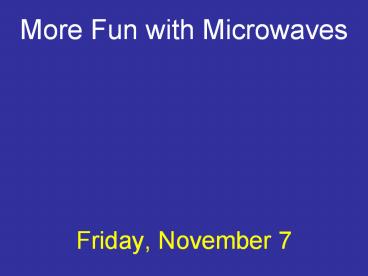More Fun with Microwaves - PowerPoint PPT Presentation
Title:
More Fun with Microwaves
Description:
... Galaxy (v 50 km/sec) Local Group falls toward Virgo Cluster (v 200 km/sec) ... by Galaxy, Galaxy tugged by Andromeda, Local Group tugged by Virgo Cluster. ... – PowerPoint PPT presentation
Number of Views:24
Avg rating:3.0/5.0
Title: More Fun with Microwaves
1
More Fun with Microwaves
- Friday, November 7
2
Evidence in favor of the Hot Big
Bang model.
1) The night sky is dark.
2) Galaxies show a redshift proportional to their
distance.
3) The universe is filled with a Cosmic
Microwave Background (CMB).
3
CMB light left over from early, hot, dense,
opaque universe.
Universe became transparent when scale
factor was a 1/1000,
time was t 400,000 years.
From then until now (t 14 billion years), CMB
photons have been freely moving through space.
4
When we observe the CMB, we see a message direct
from the early universe.
What is this message telling us?
Messages are often (1) hard to read (2) hard to
interpret.
5
Observing the CMB
COBE
WMAP
Water vapor in Earths atmosphere absorbs
microwaves go above the atmosphere!
6
WMAP (Wilkinson Microwave Anisotropy Probe) is at
the L2 point, beyond the Moons orbit.
7
Weve looked at the spectrum of the CMB (its a
blackbody), now lets look at a map.
Spherical Earth can be projected onto a flat map
So can the celestial sphere
(visible light)
8
Mapping the CMB (color temperature)
Observation Temperature of CMB is nearly
isotropic (the same in all directions).
Interpretation early universe was nearly
homogeneous (the same in all locations).
9
? hotter
cooler ?
Observation Temperature of CMB is slightly
hotter toward Leo, cooler toward Aquarius (on
opposite side of sky).
Temperature fluctuation 1 part per 1000.
10
Interpretation difference in temperature results
from a Doppler shift.
Earth orbits Sun
(v 30 km/sec)
Sun orbits center of the Galaxy
(v 220 km/sec)
Galaxy falls toward Andromeda
Galaxy (v 50 km/sec)
Local Group falls toward Virgo
Cluster (v 200 km/sec)
11
Net motion toward Leo, with a speed v 300
km/sec 0.001 c.
blueshifted (Leo)
redshifted (Aquarius)
Cosmic light from direction of Leo is slightly
blueshifted (shorter wavelength, higher
temperature).
12
The CMB is slightly hotter toward Leo because of
our motion through space.
Earth tugged by Sun, Sun
tugged by Galaxy, Galaxy tugged by
Andromeda, Local Group tugged by Virgo Cluster.
All this is happening locally, right now.
13
What can the CMB tell us about the early
universe, at the time everything became
transparent?
cool tenuous neutral transparent
hot dense ionized opaque
14
Observation After subtracting the effect of our
motion through space, CMB still shows hot cold
spots, about 1 degree across.
Temperature fluctuation 1 part per 100,000
15
Interpretation observed temperature fluctuations
result from density fluctuations in the early
universe.
Regions that were compressed had higher density,
but also higher temperature (gases heat up as
they are compressed).
16
Hot spots in the CMB are higher in temperature
than cold spots by only 1 part per 100,000.
Implication the density fluctuations in the
early universe were also small (about 1 part per
100,000).
17
(If the Earth were smooth to within 1 part
per 100,000, highest mountains would be just
70 yards above the deepest valleys.)
18
The Rich Get Richer, the Poor Get Poorer.
A region that was slightly denser than average
will eventually become much denser than average
its compressed by its own gravity.
19
Great Oaks from Tiny Acorns Grow.
A dense region that initially has a small mass
will become more massive with time its gravity
attracts surrounding matter.
20
Its possible (with a big computer) to simulate
the growth of density fluctuations.
- Make a large (imaginary) box.
- Fill it with (simulated) massive particles.
- Make sure particles are packed a little closer
together in some places than others.
-Let er rip.
21
then
now
redshift 29
redshift 0
(The size of the box grows from 1.5 Mpc to 43
Mpc.)
22
Generic result matter distribution goes from
smooth to lumpy.
23
The past is a foreign country they do things
differently there. L. P. Hartley
The past (t 400,000 years)
Hot, dense, opaque, nearly homogeneous.
Now (t 14 billion years)
Cold background radiation, low average density,
mostly transparent, very lumpy
24
What lies beyond the surface of the fog?
Since the very early universe was opaque, we
cant see it directly.
Can we deduce indirectly what the universe was
like then?
25
There is hope!
The Sun is opaque, but from our knowledge of
physics, we can deduce what its like inside.
26
Mondays Lecture
Energy Power
Reading
Chapter 9































